Beatriz Milhazes: Rigor and Beauty
Installation view, Beatriz Milhazes: Rigor and Beauty, March 7, 2025 – September 14, 2025, Solomon R. Guggenheim Museum, New York. Photo: David Heald © Solomon R. Guggenheim Foundation, New York
(NEW YORK, NY) The Guggenheim New York presents the first museum exhibition in New York devoted to the work of Beatriz Milhazes (b. 1960, Rio de Janeiro), a global contemporary artist who engages with her Brazilian cultural heritage and identity through the language of abstraction. This focused exhibition features a group of fifteen paintings and works on paper from 1995 to 2023, drawn from the museum’s permanent collection and augmented by key loans, which together contextualize the broader narrative of her artistic evolution.
Renowned for her bold, colorful abstractions, Milhazes’s complex body of work spans four decades, from the 1980s to the present. Her practice encompasses sculpture, collage, print, textiles, public art, and especially painting, all featuring intricate patterns and dynamic forms grounded in geometry.
Beatriz Milhazes, In albis, 1995–96. Acrylic on canvas, 72 1/2 × 117 7/8 in. (184.2 × 299.4 cm). Solomon R. Guggenheim Museum, New York, Gift, The Bohen Foundation 2001.219. © Beatriz Milhazes. Photo: Ariel Ione Williams, Solomon R. Guggenheim Museum, New York
Milhazes’s work is deeply rooted in Brazilian history and tradition, drawing from colonial art and architecture, decorative arts, and the vibrant celebration of Carnival—a week-long festival in Rio de Janeiro that showcases Brazilian culture through parades, music, performances, and elaborate costumes. She is also influenced by Tropicália, a 1960s cultural movement that blended art, music, and literature to celebrate Brazilian identity while protesting the repressive military regime. The rhythms and colors of bossa nova, a musical style born in Rio de Janeiro in the late 1950s, also echo throughout her work. Beyond these influences, she engages with the work of artists like Henri Matisse, Piet Mondrian, and Tarsila do Amaral, whose creations were fundamental to the visual and aesthetic developments of Brazilian Modernism.
Beatriz Milhazes, Santa Cruz, 1995. Acrylic on canvas, 76 1/4 × 120 1/4 in. (193.7 × 305.4 cm). Solomon R. Guggenheim Museum, New York, Gift, The Bohen Foundation 2001.220. © Beatriz Milhazes. Photo: Ariel Ione Williams, Solomon R. Guggenheim Museum, New York
“The Guggenheim is thrilled to present the first New York museum exhibition of Beatriz Milhazes. Her colorful abstractions interweave references to art history and the natural world while merging Brazilian cultural motifs with modernist influences. The show offers a rare opportunity to engage with her unique creative process and see how she reinforces her Carioca roots, creating an elaborate lexicon of allusions and symbols within a vernacular Brazilian context, ” states
Geaninne Gutiérrez-Guimarães, Curator, Guggenheim Museum Bilbao and Solomon R. Guggenheim Museum and Foundation, New York.
Beatriz Milhazes, O cravo e a rosa (The Carnation and the Rose), 2000. Acrylic on canvas, 94 1/2 × 95 in. (240 × 241.3 cm). Solomon R. Guggenheim Museum, New York, Gift, The Bohen Foundation 2001.223. © Beatriz Milhazes. Photo: Ariel Ione Williams, Solomon R. Guggenheim Museum, New York
In 1989 Milhazes developed an innovative technique she calls “monotransfer, ” inspired by the monotype printing process, in which a painted image is transferred from a plate to paper, producing a mirror image. The artist’s methodical process begins with painting motifs onto clear plastic sheets with acrylic paint. Once the acrylic dries, she layers and adheres the painted films to canvas one by one, constructing her abstract compositions through the careful arrangement of these distinct motifs. She then peels away the plastic sheets, revealing the forms in reverse. Since the painting process is unpredictable, her canvases often contain incomplete or faint structures formed by residual traces of paint from previous works, as she reuses the same plastic sheets over many years. Milhazes embraces these elements as acts of chance and improvisation, integrating them into new pieces as fortuitous inclusions. The result is a densely textured composition in which vibrant colors, organic shapes, and geometric patterns interact harmoniously on a surface imbued with the memory of the artist’s actions.
Beatriz Milhazes, As quatro estações (The Four Seasons), 1997. Acrylic on canvas, 101 1/2 × 112 1/8 in. (257.8 × 284.8 cm). Solomon R. Guggenheim Museum, New York, Gift, The Bohen Foundation 2001.222. © Beatriz Milhazes. Photo: Ariel Ione Williams, Solomon R. Guggenheim Museum, New York
The early paintings in this exhibition, primarily from the museum’s collection—such as Santa Cruz (1995), In albis (1995–96), and As quatro estaçōes (The Four Seasons, 1997)—draw inspiration from the opulence of 18th-century Brazilian Baroque colonial churches and ornamental garments. Milhazes synthesizes these influences into abstract and representative motifs, with circles and arabesques, delicate crochet and lace, flowers and floral patterns, decorative ruffles and ribbons, and ornate pearls and ironwork emerging throughout her compositions. By 2000, Milhazes began exploring optical effects in her paintings, using linear repetitions to create undulating patterns and visual rhythm, as seen in Paisagem carioca (Carioca Landscape, 2000), O cravo e a rosa (The Carnation and the Rose, 2000), and O Caipira (The Caipira, 2004).
Beatriz Milhazes (b. 1960, Rio de Janeiro), Carioca Landscape (Paisagem carioca),2000. Acrylic on canvas, 67 × 79 in. (170.2 × 200.7 cm). Solomon R. Guggenheim Museum, New York, Gift, The Bohen Foundation 2001.224. © Beatriz Milhazes. Photo: Ariel Ione Williams, Solomon R. Guggenheim Museum, New York
The works on paper in this exhibition, spanning 2013 to 2021, demonstrate Milhazes’s continued experimentation with the medium, particularly since she began formally creating collages during a 2003 residency at the Centre d’art contemporain du Domaine de Kerguéhennec in Bignan, France. Combining mass-produced elements like branded shopping bags, chocolate bar wrappers, and patterned paper with cutouts from solid-colored screenprints, Milhazes creates patterns with recurring motifs such as arabesques, stars, leaves, flowers, circles, squares, and rectangles. Her collages function like personal journals, reflecting fragments of the artist’s reality and her commitment to color and inventive form.
Her recent paintings, including Mistura sagrada (Sacred Mixture, 2022), mark a shift toward exploring the spiritual power of nature in the wake of the COVID-19 pandemic. Although references to the natural world have been present since her early career, here she delves into cycles of renewal—life and death—through colorful, angular forms and intricate patterns. Organic elements, reflective of Milhazes’s proximity to Rio de Janeiro’s Botanical Garden, Tijuca Forest, and Copacabana Beach, are echoed in the harmonious geometries, conceptual systems, and chromatic universes that span her oeuvre.
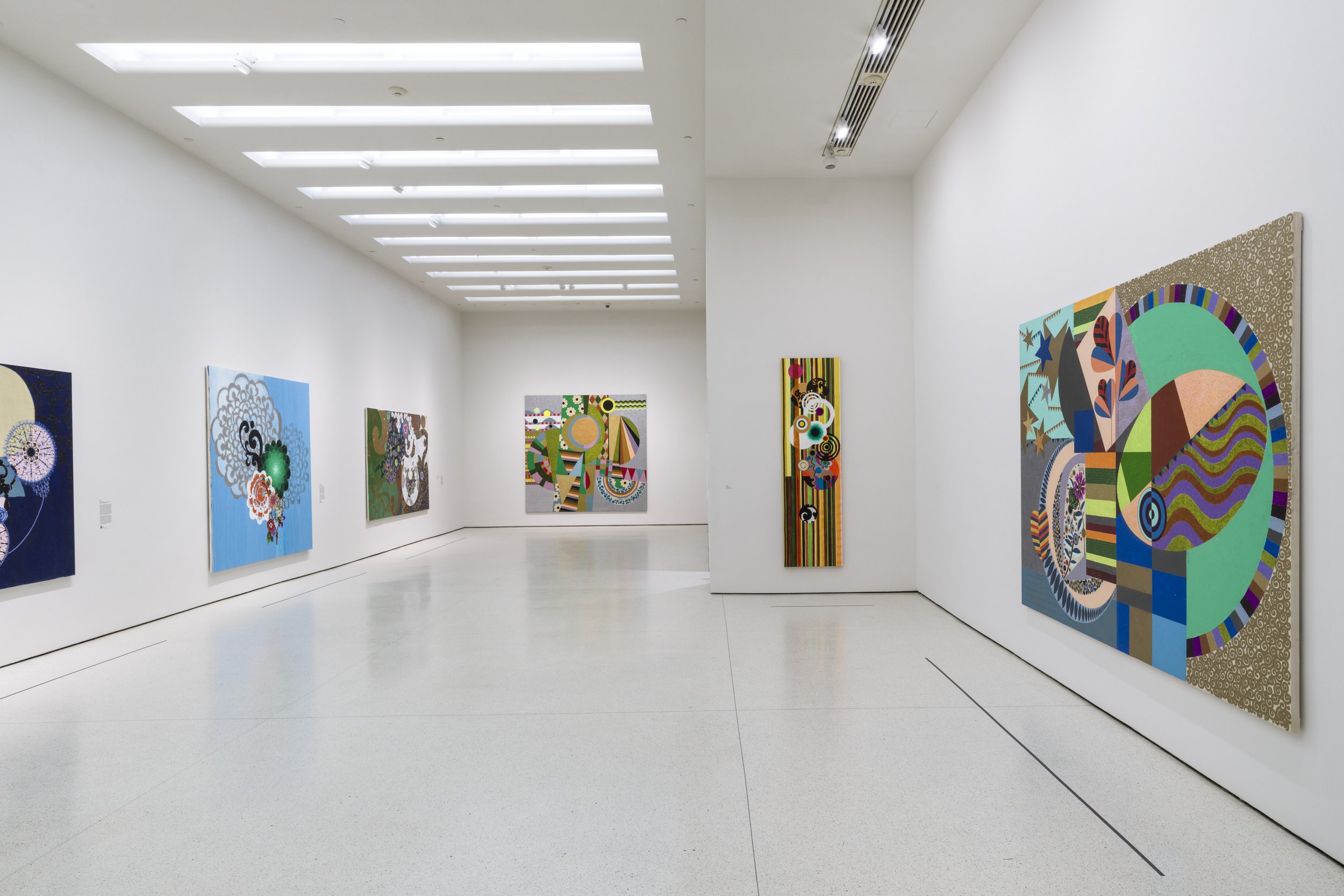
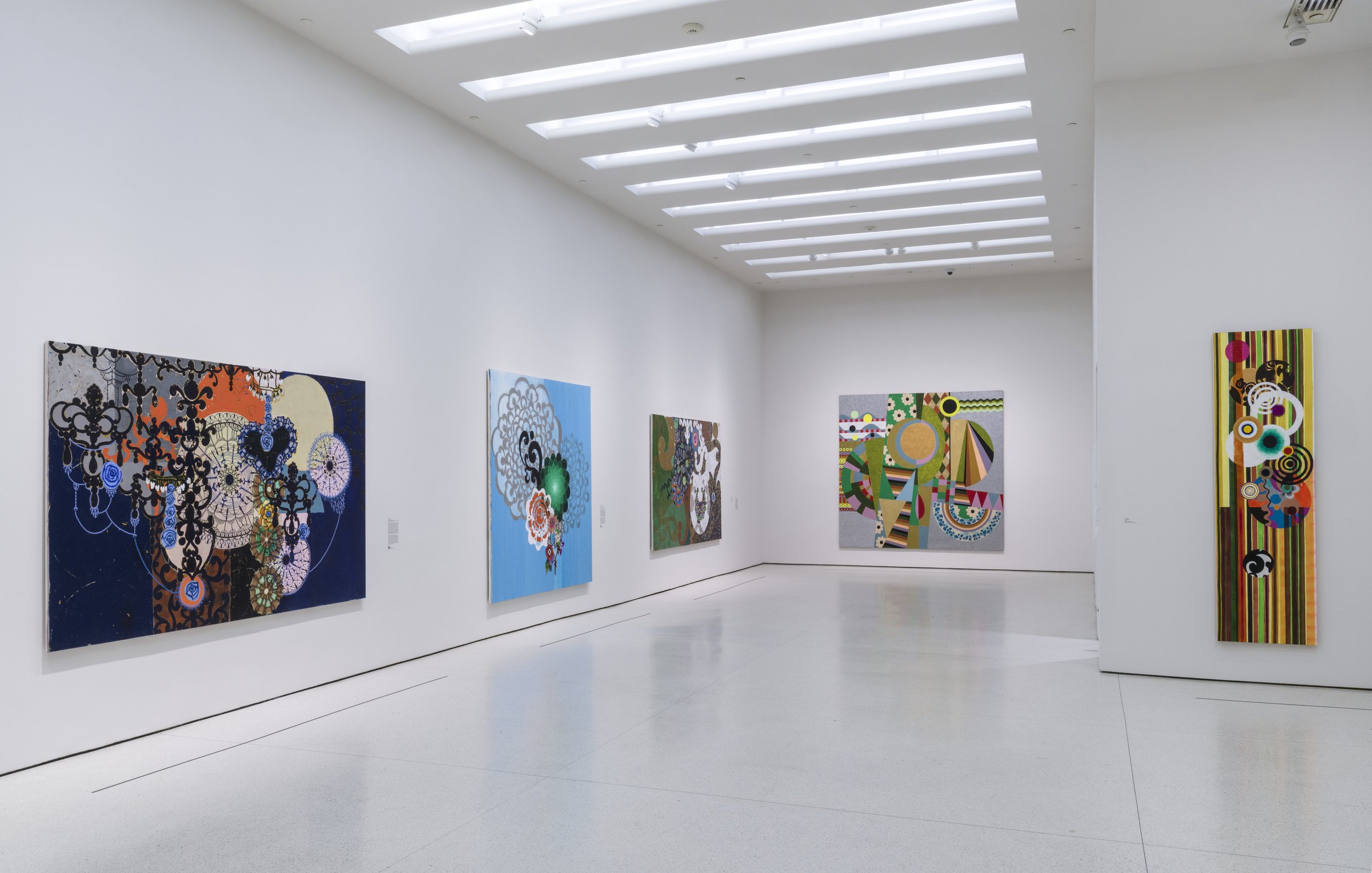
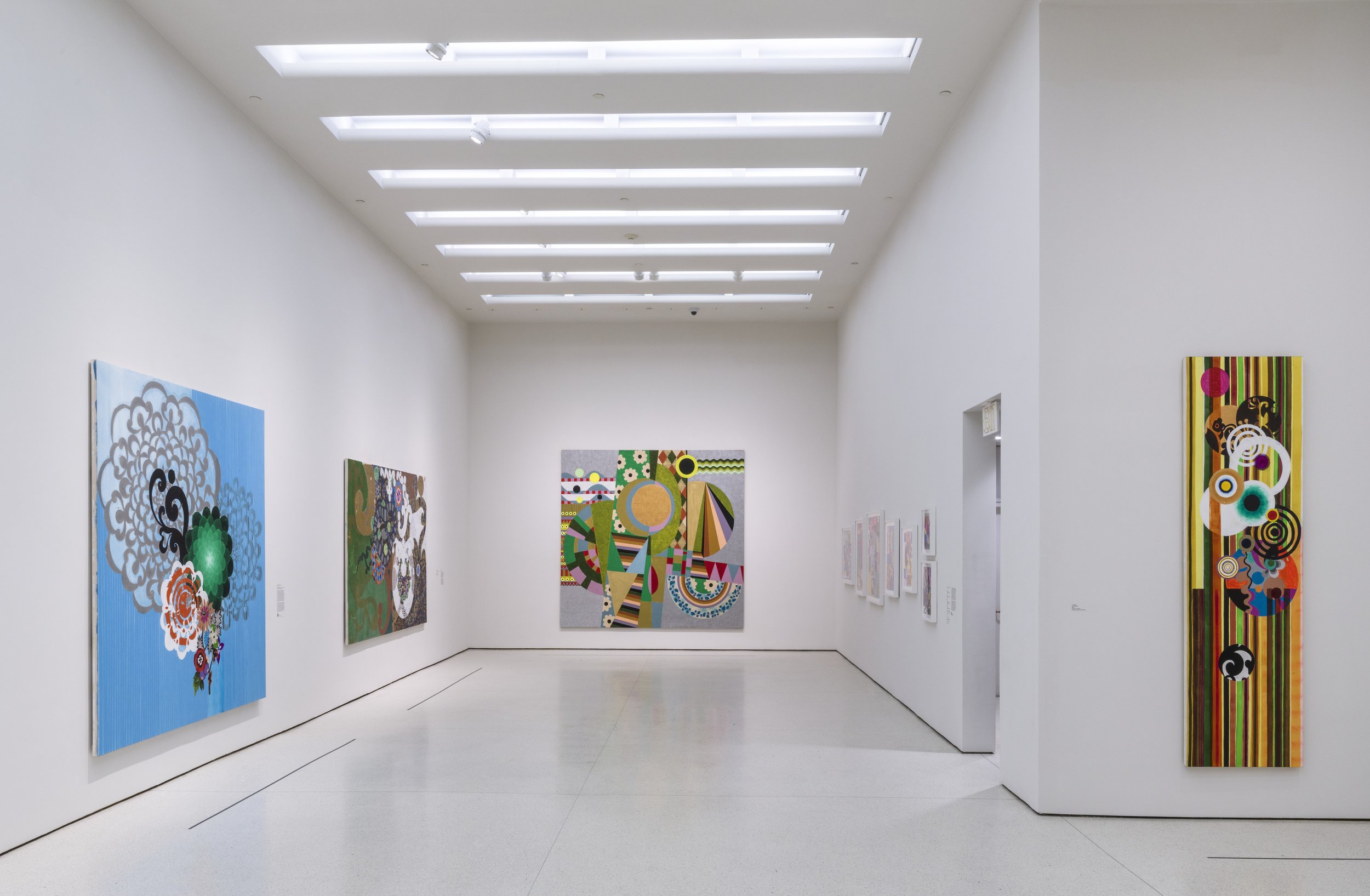


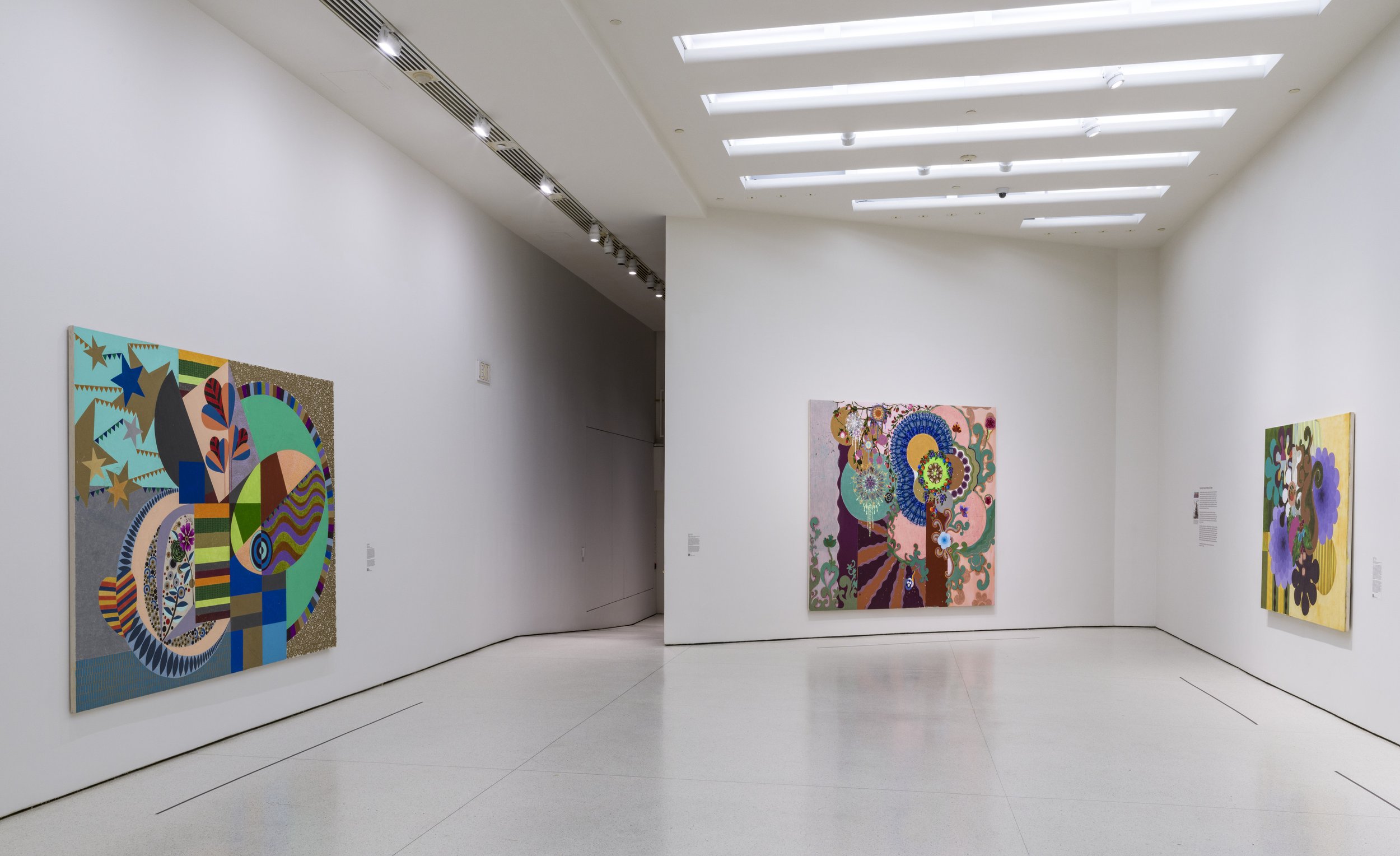

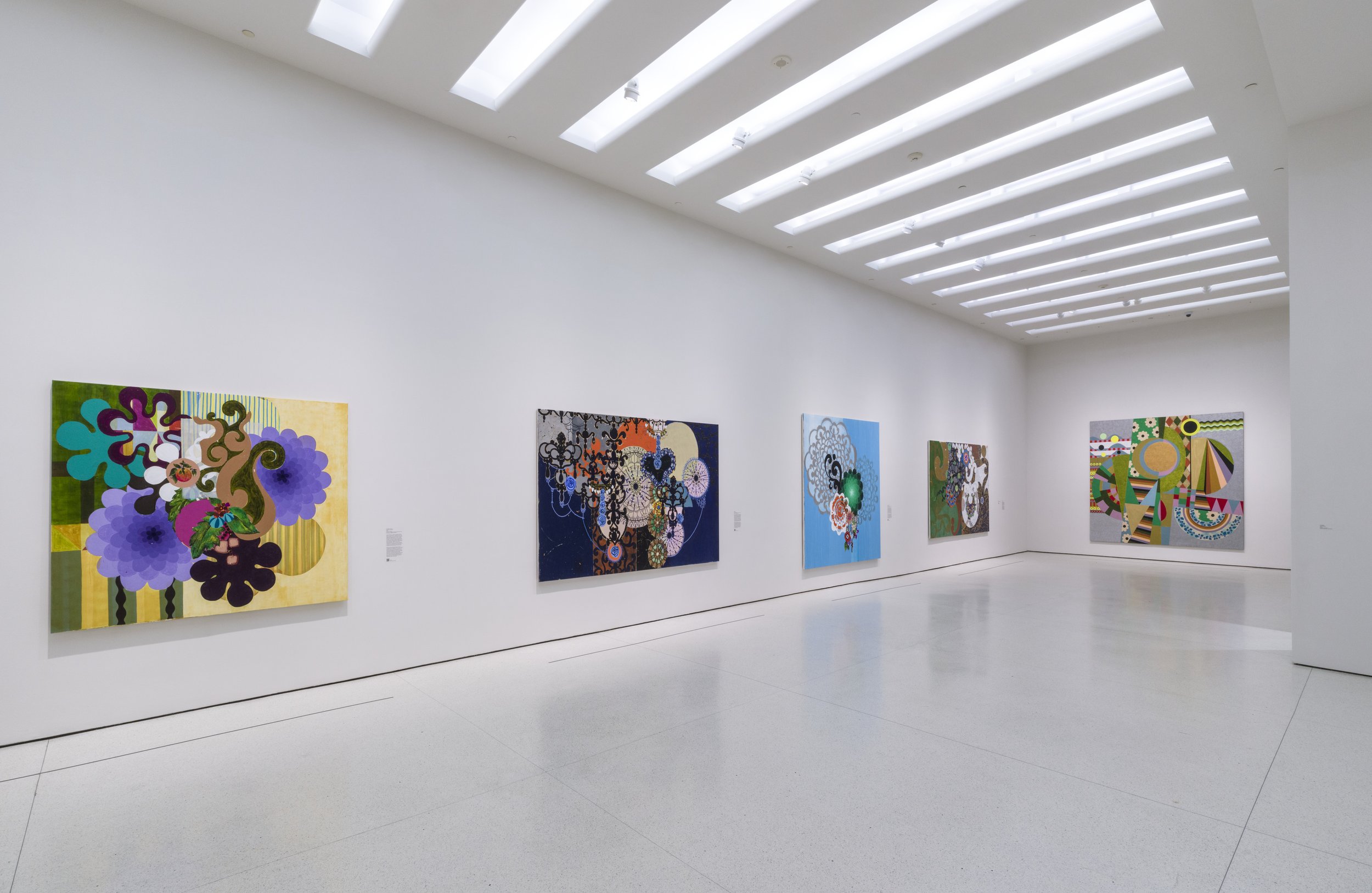
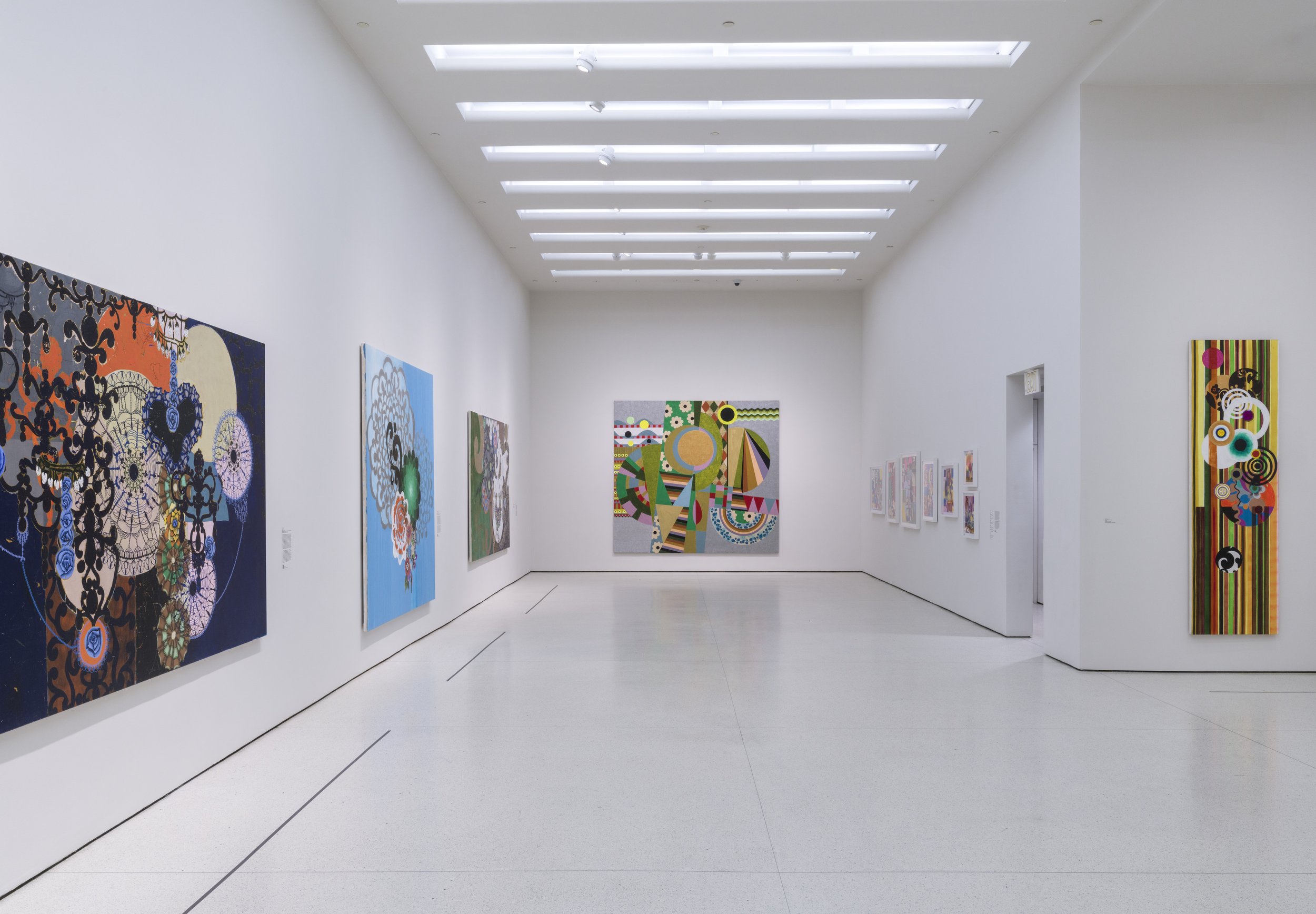


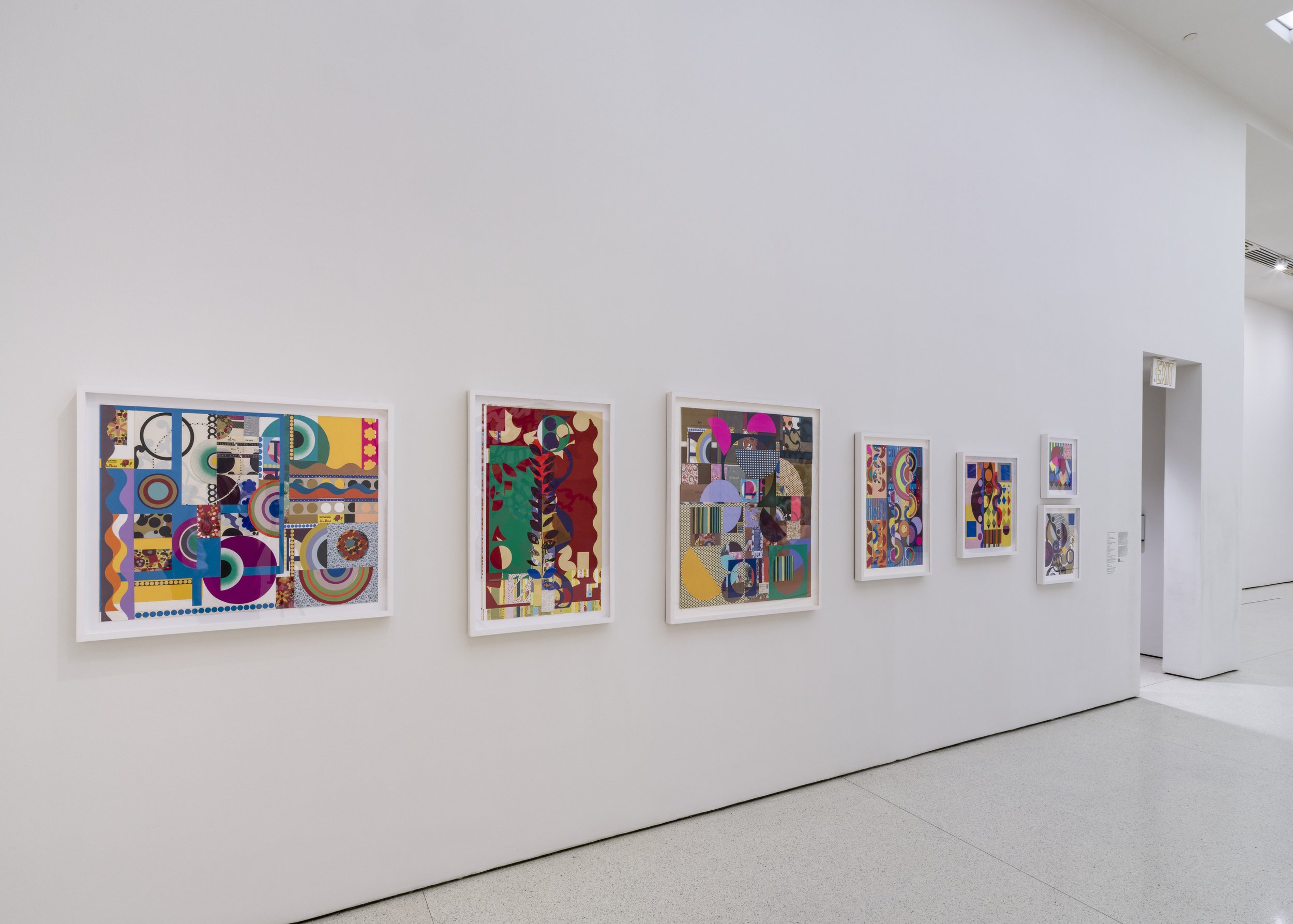
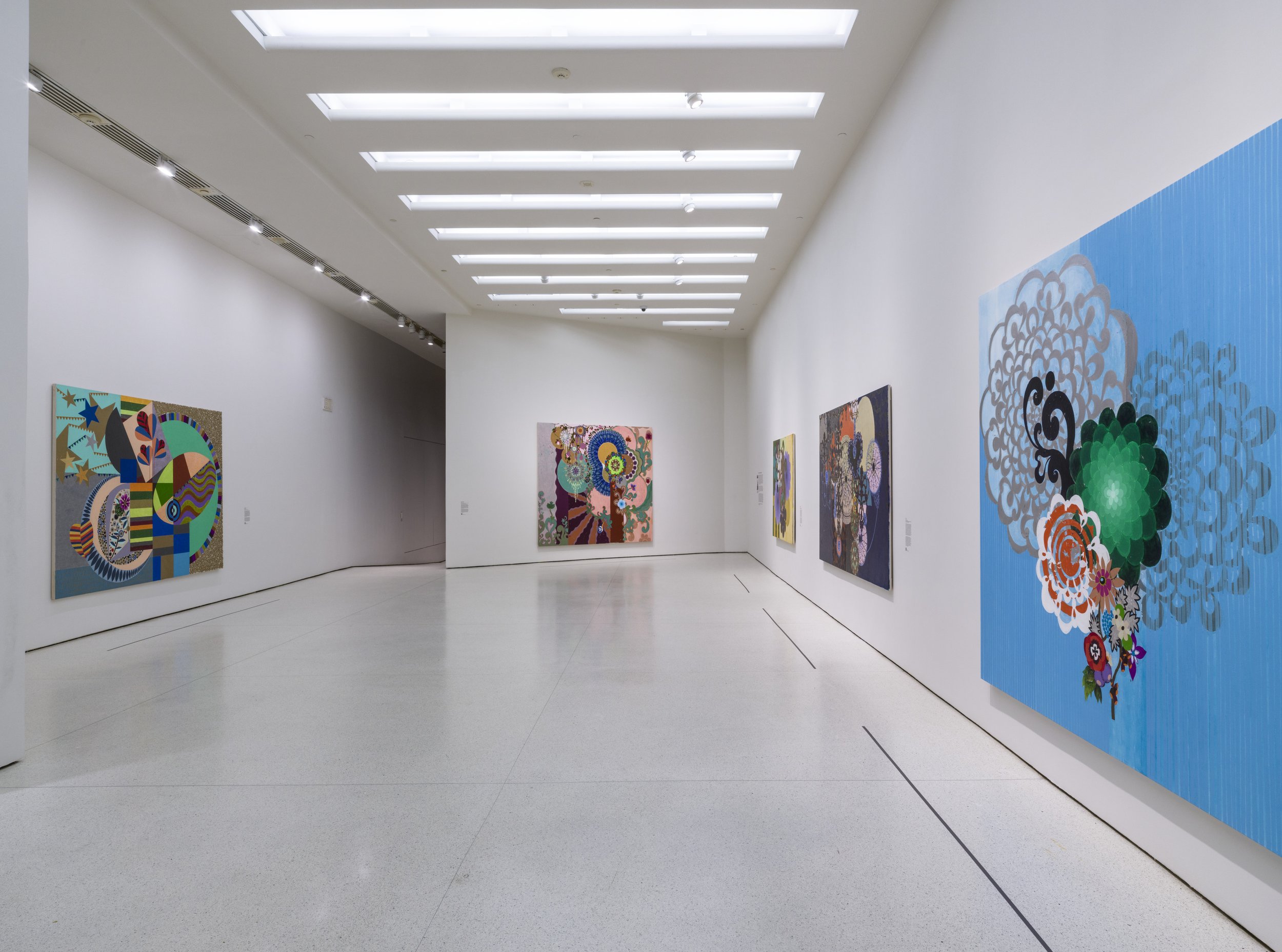
Installation view, Beatriz Milhazes: Rigor and Beauty, March 7, 2025 – September 14, 2025, Solomon R. Guggenheim Museum, New York. Photo: David Heald © Solomon R. Guggenheim Foundation, New York
“With almost thirty years between the earliest and most recent works in this exhibition, the pieces interact in remarkable ways, creating a strong and distinctive visual confrontation while offering a valuable opportunity to observe their evolution. I would especially note the convivial relationships between abstraction, figuration, geometry, and free forms in these works, as well as the superposition of their paint layers. The colorful compositions diverge from dark and melancholic to bright and intricate, creating a dynamic atmosphere in the exhibition ”
This exhibition is the second installment in the exhibition series Collection in Focus, which highlights the museum’s permanent collection. The series is part of a reinvigorated effort to make the Guggenheim New York’s world-renowned holdings more accessible to the public. Beatriz Milhazes: Rigor and Beauty is organized by Geaninne Gutiérrez-Guimarães, Curator, Guggenheim Museum Bilbao and Solomon R. Guggenheim Museum and Foundation, New York.
Programming
On the occasion of the exhibition, Beatriz Milhazes will participate in a public program on May 20, 2025, as part of the museum’s Conversations with Contemporary Artists series. Additional educational activities will include gallery talks within the exhibition, which will be free with museum admission.
Beatriz Milhazes in front of her painting The Four Seasons (As quatro estações, 1997) in 2024. © Solomon R. Guggenheim Museum, New York. Photo: David Heald, Solomon R. Guggenheim Museum, New York
About the Artist
Beatriz Milhazes was born in Rio de Janeiro in 1960 and continues to live and work there. She earned a degree in journalism from Faculdades Integradas Hélio Alonso in 1981 and attended open courses at the Escola de Artes Visuais do Parque Lage (EAV) from 1980–82. In 1984, she participated in Como vai você, Geração 80?, a seminal exhibition marking the return to painting in Brazil. In 1986, she became a teacher at EAV, where she taught for ten years. In 1989, she developed her signature “monotransfer” painting technique and dedicated herself fully to her artistic practice.
Milhazes has a longstanding relationship with the Guggenheim New York, dating back to 1992 when curator Richard Armstrong (former director of the Solomon R. Guggenheim Museum, New York, 2008–23) and Fred Henry, president of the Bohen Foundation, visited her studio in Rio de Janeiro at the recommendation of Brazilian art critic and curator Paulo Herkenhoff. Milhazes later participated in Armstrong’s Carnegie International 1995 exhibition at the Carnegie Museum of Art, Pittsburgh, in 1995—her first major show outside of Latin America—earning international recognition. In 1998, Herkenhoff included her work in the São Paulo Biennial, while Armstrong continued to follow her career. Moreover, Fred Henry became an avid collector of her work and eventually acquired five of Milhazes’s paintings for the Bohen Foundation. In 2001, the Bohen Foundation donated a sizeable collection to the Guggenheim Museum under former director Thomas Krens (1988–2008). This significant bequest, primarily consisting of film, video, new media, and installation art, also included six works by Milhazes, along with pieces by other Brazilian artists.
In 2002, Milhazes had her first museum solo show at the Centro Cultural Banco do Brasil, Rio de Janeiro. Since then, she has held numerous national and international solo exhibitions and received several artist commissions, including at Pinacoteca de São Paulo (2008); Fondation Cartier pour l’art contemporain, Paris (2009); Fondation Beyeler, Riehen, Switzerland (2011); Pérez Art Museum Miami (2014); the Jewish Museum, New York (2016); Museu de Arte de São Paulo (MASP) with Itaú Cultural, São Paulo (2020); Long Museum, Shanghai (2021); Turner Contemporary, Margate, England (2023); and Tate St Ives, Cornwall, England (2024). She also participated in the Biennial of Sydney (1998), São Paulo Biennial (1998, 2004, 2013), Shanghai Biennial (2006), Mercosul Biennial (2015), and the Venice Biennale (2003, 2024), with a special project at the Pavilion of Applied Arts at the most recent Venice Biennale
Support
Visionary support for Collection in Focus is provided by Aleksandra Janke and Andrew McCormack.
The Leadership Committee for Beatriz Milhazes: Rigor and Beauty is gratefully acknowledged for its generosity, with special thanks to Laura Clifford, Peter Bentley Brandt, Christina and Alan MacDonald, Cristina Chacón and Diego Uribe, Alberto Cruz, Ilva Lorduy, Karina Mirochnik and Gaby Szpigiel, Pace Gallery, White Cube, Fortes D’Aloia & Gabriel, and Galerie Max Hetzler. Additional funding is provided by the Guggenheim New York’s Latin American Circle.
About the Guggenheim New York
The Solomon R. Guggenheim Foundation was established in 1937 and is dedicated to promoting the understanding and appreciation of modern and contemporary art through exhibitions, education programs, research initiatives, and publications. The international constellation of museums includes the Guggenheim New York; the Peggy Guggenheim Collection, Venice; Guggenheim Bilbao; and the future Guggenheim Abu Dhabi. An architectural icon and “temple of spirit” where radical art and architecture meet, the Guggenheim New York is now among a group of eight Frank Lloyd Wright structures in the United States recently designated as a UNESCO World Heritage site. To learn more about the museum and the Guggenheim’s activities around the world, visit guggenheim.org.
Beatriz Milhazes: Rigor and Beauty will be on view at Guggenheim New York, 1071 Fifth Avenue, New York in Tower 5. From March 7 to September 14, 2025
To learn more about the museum, this exhibit, past exhibits, current exhibits, upcoming exhibits, and the Guggenheim’s activities around the world, visit here. The museum can also be found on YouTube, TikTok, X, Facebook, and Instagram.






